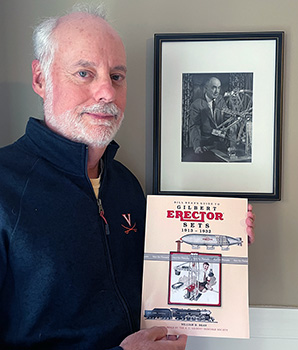Review by Michael D. Foster, ACGHS Newsletter, December 2021
The revised and updated Bill Bean’s Guide to Gilbert Erector Sets, 1913-1932 is here. It’s been a lengthy wait for some, and an anticipated accomplishment for many; however, the waiting is finally over. I know members will be anxious to add this coveted edition to their collections, so first things first. It will be important to know how to obtain your copy.

Note: The ACGHS will not be selling the book directly; however, copies will be made available whenever possible at Conventions and Regional meetings to ACGHS members for $39.00.
You may purchase your copy of Bill Bean’s Guide to Gilbert Erector Sets, 1913-1932 through Amazon as an “on-demand” product, which is available immediately. The cost of the book is $49.00. Search “Guide to Gilbert Erector Sets” in the Amazon search bar or follow this link: https://www.amazon.com/dp/0578994372/
In review: The overall goal of the update was to revise any incorrect information, update the Erector Set Content Lists, add set photos wherever possible and to add stories never told before. This objective was more than accomplished! The revision includes an additional 64 pages to the previous guide, 45 new photographs and illustrations, and a new PREFACE by Bruce Watson which shares an interesting insight into A. C. Gilbert and this guide. The section, “How to Use this Erector Guide” was updated with the addition of an interesting Patent illustration and a new “Estimating A Set’s Value” system. This new and improved system is a more simplified method, which is still based on the condition, completeness and organization of the sets. The primary change is that instead of a rigid set value, each set is given a range which increases with the number of $ assigned. The ranges are listed at the top of the page listing the sets and description, making it easy to assign a value. I believe this is an important improvement over the previous system, given that an Erector set’s value is so subjective and if two collectors are battling for a set on e-bay, the value is typically set by who wants it the most.
Chapter 1 changes include the updated A. C. Gilbert story and history with new photos from the private “Gilbert Family Collection” and a three-quarter page graphic of the 1913 U.S. patent for Gilbert’s early girder design and system. Many new photos from ACGHS members have also been added. When you get your copy of the update, don’t feel compelled to skip over Chapter 1, as it is definitely worth the read.
The ever important and most used section of the book is the Sets section, Chapter 2 and Chapter 3. They have both been updated with new and corrected information, but a major change was putting the “Erector Content Lists” in the back of the book under a new Appendix. Not only is this an improvement in organization, but also in ease of use. As mentioned previously, the set’s value system was simplified and improved in this section. This section also includes many new set photos and graphics from ACGHS members. Chapter 2 also now includes a two-page article with photos of A.C. Gilbert’s Commemorative Erector Set. This is something every A. C. Gilbert fan will want to read.
The inclusion of new photos and graphics is no exception in Chapter 4, The Classic Period Models. And in this chapter, we are treated with a new two-page article and photos of “One-Of-A-Kind Erector Models.”
The guide update concludes with a new Appendix, mentioned earlier, which includes all of the Content List for Erector sets. On the last page of the Content List, we are rewarded with a photo of A.C. Gilbert Co-Workers in 1921. (Courtesy of the Eli Whitney Museum and Workshop.)
In comparing the two guides, one of the first things you will notice is that the update is soft cover opposed to hard cover like the original guide. If you are a collector, you might prefer the more “elite” looking 1993 Greenberg hard cover. If you use your guide as much as I do, you will find the soft cover easier to use. My suggestion would be to purchase two of the revised version and keep one for the collection and one for daily use.
The color of the cover has also changed from Erector red to a light tan which was taken from the background of the 1929 Erector catalog, so you could say it’s still an Erector color. They look quite handsome on the shelf together and the new edition is easily identifiable.
Another difference between the original guide and the update is the printing process used. The original guide was printed using a 4-color offset press and the update was printed using a digital press. While offset printing is the best quality, improved technology has made digital quality very close and at times indistinguishable to offset. For small quantity printing, digital is the most cost effective.
I would also like to comment on the overall page layout and design of the updated guide. There are three changes that make the update easier to read and locate whatever you are looking for. First, putting the Content Lists in the back of the book opens up the pages. Second, the font is larger and leading (space) between lines has increased. And last, many photos and graphics are larger. In conclusion, I feel the updated Bill Bean’s Guide to Gilbert Erector Sets is a winner. For the collector this revised guide is a valuable resource and tool and every collector and A.C. Gilbert enthusiast is sure to want to add this update to their collection. Santa says, “There still is time to add it to your Christmas List this year!”
Bill Bean’s Guide to GILBERT ERECTOR SETS, 1913-1932
By William M. Bean
Edited by David T. Gilbert
Published by the A.C. Gilbert Heritage Society
$49
